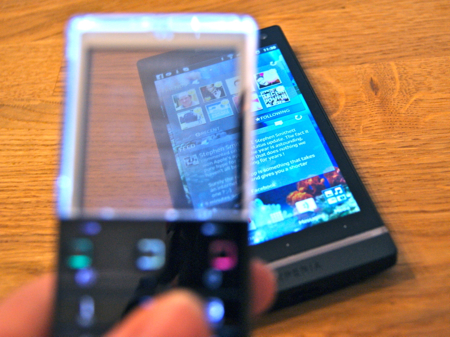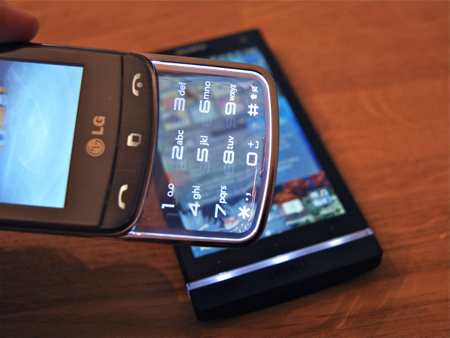Sony Xperia S - Part 2: Form factor, media, storage
Off to a great start

< Part 1: Introduction - Introduction, specs, build quality
See-through the hype
At the bottom of the phone is a transparent band, which houses the antenna and also shows three illuminated icons for the back, home, and menu buttons.
Except the actual buttons aren't there. They are in fact housed in small dots slightly above these. To press them requires a pretty accurate touch, and I soon discovered that a short swiping action (i.e. rubbing over the dot) netted a more positive result and avoided frustration.


There's no option to adjust the sensitivity of these buttons, so it does require a fair bit of practice. If I had to pick one thing on the handset that I really don't like, it's the need to get used to pressing keys you'll be using all of the time. You do get used to it eventually, but you shouldn't need to.
Sony argues that the transparent bar is there to improve the antenna performance, and the reception on the phone was easily as good as other phones I've tested in the same locations. Nevertheless, I remain sceptical that the transparency makes much of a difference over a bit of thin black (or white) plastic.
Still, it's a talking point, and every manufacturer needs an edge these days. Sony has definitely got one here, and you'll see the same antenna design on many more Xperia handsets released this year, for better or worse.


This isn't the first product to dabble with transparent materials. The Xperia Pureness had a totally transparent monochrome display, while LG released the Crystal with a transparent keypad. Both of these were regarded as gimmicks and the phones sold poorly, but fortunately the Xperia S has plenty of positive features that more than compensate.
Hook me up
The fact that there's a micro-USB port on one side of the phone and an HDMI port on the other is not one of these positive features. It means Sony can't build a docking station with the phone, while the LiveDock accessory released last year only lets you position the phone in portrait mode without falling off.
The LiveDock enables you to connect accessories, such as keyboards, mice, game controllers, or even USB flash drives while keeping the phone charged, so it could still be a worthwhile purchase.
Another option is to purchase a simple USB On-The-Go cable (available for £2 or less on Amazon and eBay) and connect USB devices directly to the phone. The only caveat is that you can't power all USB devices that way, nor can you charge the phone at the same time.
You only need the bundled HDMI cable to connect to a TV, but either of the above options will also let you connect a keyboard and/or mouse and be more productive than simply mirroring the phone display, with you having to use the phone itself to navigate menus, select content, or enter text.
Alternatively, as this is a Sony product, there's the option to send content via DLNA to your suitably equipped TV. Sony has included a simplified menu when connected to a TV, as well as apps for its own Music and Video Unlimited services.
The former offers unlimited music for a fixed monthly fee, while the latter doesn't actually offer unlimited movie access but allows you to rent, or buy, films via your phone.
Sony now has strong competition from a range of alternative services, including Spotify and Google's own Play service. It won't be long until Sky Go is officially available for the Xperia S, too, offering access to sport and movies as part of your standard monthly subscription.
The Xperia S is also a PlayStation-Certified device, meaning you can access a back catalogue of original PlayStation games, which look quite archaic on the HD display. I can't see many people wanting to buy these games over titles like Angry Birds Space or SoulCraft.
Thanks for the memory
For storing content there's 32GB of storage space built into the phone. There's no memory card slot, which may disappoint many, but there's method to this madness according to Google, as the fixed storage space ensures apps won't suffer from data loss if your memory card is removed or mounted as a drive on your desktop.
Although Mac will lose the ability to mount the phone as a drive and drag and drop files (instead you'll need to download a free app called Sony Bridge for Mac, which functions more like iTunes does with an iPhone), PC users will still get similar functionality – but with all of the data still accessible by the phone at the same time as on your computer.
In an ideal world, Sony would have included fixed-storage and a card slot, but 32GB is still generous, and more than most people will ever get by never upgrading the 2, 4, or 8GB card included with their new phone.
Other things to note include the handset being the first from Sony to use a micro-SIM, and the 1,750mAh battery being non-replaceable. The phone supports a fast-charging mode, which can get it to around 80 per cent in just 30 minutes (trickle-charging for the remaining 20 per cent), but that also means buying a different power adapter.
The battery performance started off very poorly, even after a number of charges - almost to the point that I wondered whether it would be possible to make it beyond mid-afternoon.
Even after a firmware update early on, it seemed like it wasn't going to improve. Then, by chance, I read on a forum that there was an issue with the phone switching from 2G to 3G (and back) too frequently, causing unnecessary power usage even in standby.
Sure enough, after I locked the phone to 3G the battery began to drain far slower. On its last test before I knuckled down to finish the review I managed a whole day with the battery still on a far more reassuring 49 per cent by early evening, instead of a flashing red LED notification warning of an imminent shut-down.
I now have faith that the battery is sufficient to power the display and processor, but don't expect stellar performance from the Xperia S if you decide to spend all day watching HD movies with the screen brightness on max.
